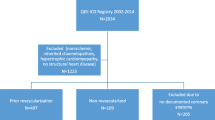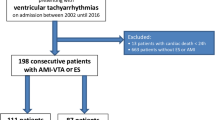Abstract
Background
Despite a few studies evaluating the prognostic impact of coronary chronic total occlusion (CTO) in implantable cardioverter defibrillator (ICD) recipients, the impact of CTO on different types of recurrences of ventricular tachyarrhythmias, as well as their predictors has not yet been investigated in CTO patients.
Methods
A large retrospective registry was used including all consecutive patients with ventricular tachyarrhythmias undergoing coronary angiography at index from 2002 to 2016. Only ICD recipients with CTO were compared to patients without (non-CTO). Kaplan–Meier and Cox regression analyses were applied for the primary end point of first recurrence of ventricular tachyarrhythmias at 5 years. Secondary end points comprised of the different types of recurrences, first appropriate ICD therapy and all-cause mortality at 5 years.
Results
From a total of 422 consecutive ICD recipients with ventricular tachyarrhythmias at index, at least one CTO was present in 25%. CTO was associated with the primary end point of first recurrence of ventricular tachyarrhythmias at 5 years (55% vs. 39%; log rank p = 0.001; HR = 1.665; 95% CI 1.221–2.271; p = 0.001), as well as increased risk of first appropriate ICD therapy (40% vs. 31%; log rank p = 0.039; HR = 1.454; 95% CI 1.016–2.079; p = 0.041) and all-cause mortality at 5 years (26% vs. 16%; log rank p = 0.011; HR = 1.797; 95% CI 1.133–2.850; p = 0.013). Less developed collaterals (i.e., either ipsi- or contralateral compared to bilateral) and a J-CTO score ≥ 3 were strongest predictors of recurrences in CTO patients at 5 years.
Conclusion
A coronary CTO even in the presence of less developed collaterals and more complex CTO category is associated with increasing risk of recurrent ventricular tachyarrhythmias at 5 years in consecutive ICD recipients.




Similar content being viewed by others
References
Townsend N, Wilson L, Bhatnagar P et al (2016) Cardiovascular disease in Europe: epidemiological update 2016. Eur Heart J 37:3232–3245
Niemeijer MN, van den Berg ME, Leening MJ et al (2015) Declining incidence of sudden cardiac death from 1990–2010 in a general middle-aged and elderly population: the Rotterdam Study. Heart Rhythm 12:123–129
Priori SG, Blomstrom-Lundqvist C, Mazzanti A et al (2015) 2015 ESC Guidelines for the management of patients with ventricular arrhythmias and the prevention of sudden cardiac death: the task force for the management of patients with ventricular arrhythmias and the prevention of sudden cardiac death of the European Society of Cardiology (ESC). Endorsed by: Association for European Paediatric and Congenital Cardiology (AEPC). Eur Heart J 36:2793–2867
Zheng ZJ, Croft JB, Giles WH et al (2001) Sudden cardiac death in the United States, 1989 to 1998. Circulation 104:2158–2163
Myerburg RJ, Junttila MJ (2012) Sudden cardiac death caused by coronary heart disease. Circulation 125:1043–1052
Eckart RE, Shry EA, Burke AP et al (2011) Sudden death in young adults: an autopsy-based series of a population undergoing active surveillance. J Am Coll Cardiol 58:1254–1261
Fefer P, Knudtson ML, Cheema AN et al (2012) Current perspectives on coronary chronic total occlusions: the Canadian Multicenter Chronic Total Occlusions Registry. J Am Coll Cardiol 59:991–997
Claessen BE, van der Schaaf RJ, Verouden NJ et al (2009) Evaluation of the effect of a concurrent chronic total occlusion on long-term mortality and left ventricular function in patients after primary percutaneous coronary intervention. JACC Cardiovasc Interv 2:1128–1134
Di Marco A, Paglino G, Oloriz T et al (2015) Impact of a chronic total occlusion in an infarct-related artery on the long-term outcome of ventricular tachycardia ablation. J Cardiovasc Electrophysiol 26:532–539
Stuijfzand WJ, Driessen RS, Raijmakers PG et al (2017) Prevalence of ischaemia in patients with a chronic total occlusion and preserved left ventricular ejection fraction. Eur Heart J Cardiovasc Imaging 18:1025–1033
Sachdeva R, Agrawal M, Flynn SE et al (2014) The myocardium supplied by a chronic total occlusion is a persistently ischemic zone. Catheter Cardiovasc Interv 83:9–16
Christofferson RD, Lehmann KG, Martin GV et al (2005) Effect of chronic total coronary occlusion on treatment strategy. Am J Cardiol 95:1088–1091
Werner GS, Gitt AK, Zeymer U et al (2009) Chronic total coronary occlusions in patients with stable angina pectoris: impact on therapy and outcome in present day clinical practice. Clin Res Cardiol 98:435–441
Chi WK, Gong M, Bazoukis G et al (2018) Impact of coronary artery chronic total occlusion on arrhythmic and mortality outcomes: a systematic review and meta-analysis. JACC Clin Electrophysiol 4:1214–1223
Kahn JK (1993) Angiographic suitability for catheter revascularization of total coronary occlusions in patients from a community hospital setting. Am Heart J 126:561–564
Jeroudi OM, Alomar ME, Michael TT et al (2014) Prevalence and management of coronary chronic total occlusions in a tertiary veterans affairs hospital. Catheter Cardiovasc Interv 84:637–643
Nombela-Franco L, Mitroi CD, Fernandez-Lozano I et al (2012) Ventricular arrhythmias among implantable cardioverter-defibrillator recipients for primary prevention: impact of chronic total coronary occlusion (VACTO Primary Study). Circ Arrhythm Electrophysiol 5:147–154
Raja V, Wiegn P, Obel O et al (2015) Impact of chronic total occlusions and coronary revascularization on all-cause mortality and the incidence of ventricular arrhythmias in patients with ischemic cardiomyopathy. Am J Cardiol 116:1358–1362
19Behnes M, Akin I, Kuche P, et al (2019) Coronary chronic total occlusions represent an independent predictor of mortality in ventricular tachyarrhythmias. EuroIntervention J EuroPCR Collab Working Group Interv Cardiol Eur Soc Cardiol
Nishikawa T, Fujino M, Nakajima I et al (2017) Prognostic impact of chronic total coronary occlusion on long-term outcomes in implantable cardioverter-defibrillator recipients with ischaemic heart disease. Europace 19:1153–1162
21Al-Khatib SM, Stevenson WG, Ackerman MJ, et al. (2017) 2017 AHA/ACC/HRS Guideline for Management of Patients With Ventricular Arrhythmias and the Prevention of Sudden Cardiac Death. A Report of the American College of Cardiology/American Heart Association Task Force on Clinical Practice Guidelines and the Heart Rhythm Society 2017
Deneke T, Israel CW, Krug J et al (2013) Indikationen zur Katheterablation bei ventrikulärer Tachykardie. Dtsch med Wochenschr 138:1952–1956
Authors/Task Force M, Dickstein K, Vardas PE et al (2010) 2010 Focused Update of ESC Guidelines on device therapy in heart failure. An update of the 2008 ESC Guidelines for the diagnosis and treatment of acute and chronic heart failure and the 2007 ESC Guidelines for cardiac and resynchronization therapy. Developed with the special contribution of the Heart Failure Association and the European Heart Rhythm Association. EP Europace 12:1526–1536
Authors/Task Force M, Windecker S, Kolh P et al (2014) 2014 ESC/EACTS Guidelines on myocardial revascularization: the task force on myocardial revascularization of the European Society of Cardiology (ESC) and the European Association for Cardio-Thoracic Surgery (EACTS)Developed with the special contribution of the European Association of Percutaneous Cardiovascular Interventions (EAPCI). Eur Heart J 35:2541–2619
Sianos G, Werner GS, Galassi AR et al (2012) Recanalisation of chronic total coronary occlusions: 2012 consensus document from the EuroCTO club. EuroIntervention J EuroPCR Collab Working Group Interv Cardiol Eur Soc Cardiol 8:139–145
Galassi AR, Werner GS, Boukhris M et al (2019) Percutaneous recanalisation of chronic total occlusions: 2019 consensus document from the EuroCTO Club. EuroIntervention J EuroPCR Collab Working Group Interv Cardiol Eur Soc Cardiol 15:198–208
Di Marco A, Anguera I, Teruel L et al (2017a) Chronic total occlusion of an infarct-related artery: a new predictor of ventricular arrhythmias in primary prevention implantable cardioverter defibrillator patients. Europace 19:267–274
Di Marco A, Anguera I, Teruel L et al (2017b) Chronic total occlusion in an infarct-related coronary artery and the risk of appropriate ICD therapies. J Cardiovasc Electrophysiol 28:1169–1178
Yap SC, Sakhi R, Theuns D et al (2018) Increased risk of ventricular arrhythmias in survivors of out-of-hospital cardiac arrest with chronic total coronary occlusion. Heart Rhythm 15:124–129
Godino C, Bassanelli G, Economou FI et al (2013) Predictors of cardiac death in patients with coronary chronic total occlusion not revascularized by PCI. Int J Cardiol 168:1402–1409
Godino C, Giannattasio A, Scotti A et al (2019) Risk of cardiac and sudden death with and without revascularisation of a coronary chronic total occlusion. Heart 105:1096–1102
Farooq V, Serruys PW, Garcia-Garcia HM et al (2013) The negative impact of incomplete angiographic revascularization on clinical outcomes and its association with total occlusions: the SYNTAX (synergy between percutaneous coronary intervention with taxus and cardiac surgery) trial. J Am Coll Cardiol 61:282–294
Acknowledgements
None.
Funding
None.
Author information
Authors and Affiliations
Corresponding author
Ethics declarations
Conflict of interest
The authors declare that they do not have any conflict of interest.
Rights and permissions
About this article
Cite this article
Behnes, M., Mashayekhi, K., Kuche, P. et al. Prognostic impact of coronary chronic total occlusion on recurrences of ventricular tachyarrhythmias and ICD therapies. Clin Res Cardiol 110, 281–291 (2021). https://doi.org/10.1007/s00392-020-01758-y
Received:
Accepted:
Published:
Issue Date:
DOI: https://doi.org/10.1007/s00392-020-01758-y




